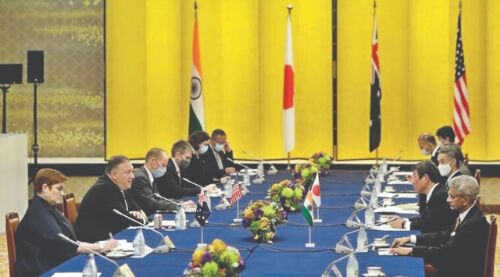Hopeful progression
Indian efforts to upgrade Quad will come after consideration of prevailing relations with China and Biden’s administrative stance on Indo-Pacific

The new Biden administration was quick off the blocks in arranging for a Quad (Quadrilateral) meeting of the United States, Australia, India and Japan through virtual mode. Coming close on the heels of the last meeting in October of this grouping, and within a month of his assumption of office, President Biden signaled a continuity of the policy of his predecessor. The Trump administration had walked an extra mile to energise this forum.
Earlier, the Biden administration declared its intent to build a substantial Indo-Pacific policy on the foundation of Quad. With relations of each of the participating countries with China remaining contentious, the third meeting at the ministerial level took up discussions on a range of issues in the region and the world, sharing the vision and goals for the Indo-Pacific region.
Intrinsic to this, is the emphasis of all four countries on their commitment to uphold rules-based international order, inherent with respect for territorial integrity and sovereignty, transparency, freedom of navigation in the international seas, and peaceful resolutions of disputes — objectives that form part of the Indo-Pacific region.
There was no specific reference to China in any of the statements, barring Japan's concern in regard to China's Coast Guard Law, with all participants concurring to oppose unilateral and forceful attempts to change the status quo in the context of the East and South China Sea.
Common elements under discussion remained the continuing challenge the world is facing on account of COVID-19, maritime security, cyber-security, humanitarian assistance and disaster relief, climate change and counter-terrorism.
Developments in Myanmar, where the military took control of the administration, came up for discussion, with India underscoring the need to uphold the rule of law and the democratic transition while the United States stressing on the urgent need to restore the democratically elected government and prioritise strengthening of democratic resilience in the broader region.
The Quad structure is in its evolutionary stage with all participants following the practice of issuing separate statements on agendas under discussion. Unlike some other groupings, this quadrilateral engagement does not yet have an institutional arrangement. It also remains to be seen how the Quad Plus format including countries like Vietnam and South Korea will emerge. Although, the latest round of the Quad countries meet referred to the centrality of ASEAN.
From India's viewpoint, the third ministerial-level meeting came around the time when New Delhi and Beijing announced disengagement of troops in Ladakh, ushering a change in ground situation to the standoff in the heights since April-May 2020.
It shows that India's association with Quad, which was upgraded to ministerial level in 2019, continues and is not necessarily tactical as some members in the strategic community interpreted. The thought behind the decision could be a result of New Delhi's experience from the 2017 Doklam impasse and the altering relations with Beijing. Adding further weight to its strategic calculation, were the developments in Galwan valley that soured bilateral relations with China.
Any further progress on Quad would be worth watching. There were stray reports of a possible summit meeting. The latest round did not offer any indication of such a possibility beyond a regular annual interaction at the ministerial level. Will the disengagement process in Ladakh alter India's attitude or the strategic calculation that made New Delhi agree to upgrade Quad remain?
A clarity on India's approach to Quad and the larger concept of Indo-Pacific will depend on the path it takes amid efforts by international community to reshape the global supply chains both in the backdrop of the US-China trade war and post-COVID-19 anxieties of deep dependence on China as the manufacturer of the world. The accent should be on economic resilience and lesser dependence on China-based supplies.
Having carved out a place as a reliable supply partner during the global health pandemic, first through supply of medicines and personal protection equipment and now through vaccines, India is favourably placed to be looked upon as a dependable partner in the new order.
The challenge remains in the form of India's ability to compete and become an integral part of the global supply chain. Incentives offered by India to attract investment, competitive terms and conducive environment to global manufacturers to shift manufacturing plants from China are yet to pick up momentum as countries like Vietnam compete for the space. India is pushing the envelope on this front through its Atma Nirbhar Bharat (self-reliance) campaign for the country to be on the springboard in the post-Covid economic reconstruction era.
While attempting to work on the economic construct aspect in the larger Indo-Pacific region, India like other countries will await the contours of Biden administration's engagement with China, which will be different from what Trump pursued but remain firmly moored in the prevailing foul mood against China at home.
Views expressed are personal



